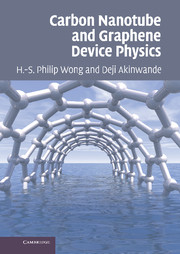Book contents
- Frontmatter
- Contents
- Preface
- 1 Overview of carbon nanotubes
- 2 Electrons in solids: a basic introduction
- 3 Graphene
- 4 Carbon nanotubes
- 5 Carbon nanotube equilibrium properties
- 6 Ideal quantum electrical properties
- 7 Carbon nanotube interconnects
- 8 Carbon nanotube field-effect transistors
- 9 Applications of carbon nanotubes
- Index
4 - Carbon nanotubes
Published online by Cambridge University Press: 05 June 2012
- Frontmatter
- Contents
- Preface
- 1 Overview of carbon nanotubes
- 2 Electrons in solids: a basic introduction
- 3 Graphene
- 4 Carbon nanotubes
- 5 Carbon nanotube equilibrium properties
- 6 Ideal quantum electrical properties
- 7 Carbon nanotube interconnects
- 8 Carbon nanotube field-effect transistors
- 9 Applications of carbon nanotubes
- Index
Summary
Doing what others have not done demands a great deal of motivation.
Sumio Iijima (pioneer in the discovery and understanding of CNTs)Introduction
There are two families of CNTs, namely single-wall CNTs and multi-wall CNTs (MWCNT) as shown in Figure 4.1. A single-wall CNT is a hollow cylindrical structure of carbon atoms with a diameter that ranges from about 0.5 to 5 nm and lengths of the order of micrometers to centimeters. An MWCNT is similar in structure to a single-wall CNT but has multiple nested or concentric cylindrical walls with the spacing between walls comparable to the interlayer spacing in graphite, approximately 0.34 nm. The ends of a CNT are often capped with a hemisphere of the buckyball structure. Carbon nanotubes are considered 1D nanomaterials owing to their very small diameter that confines electrons to move along their length. The central goal of this chapter is to understand the physical structure of CNTs, and to determine their electronic band structures, which will enable us to gain insight into the properties and performance of CNT devices.
The discussion in this chapter requires familiarity with the concepts developed in Chapters 2 and 3, such as crystal lattice and the band structure of graphene. Much of the content of this chapteris essential for the subsequent material presented throughout the book. We will use the acronym CNT to refer specifically to the single-wall variety unless explicitly stated otherwise. MWCNTs will be discussed mostly in the context of interconnect wires in Chapter 7.
- Type
- Chapter
- Information
- Carbon Nanotube and Graphene Device Physics , pp. 73 - 101Publisher: Cambridge University PressPrint publication year: 2010

